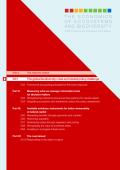Inducing environmental innovation is a significant challenge to policy-makers. Efforts to design public policies that address these issues are motivated by the fact that innovations can allow for improved environmental quality at lower cost. However, the relationship between environmental policy and technological innovation remains an area in which empirical evidence is scant. Increased attention should be paid to the design characteristics of public policies that are likely to affect the ‘type’ of innovation induced. The work presented in this book is brought together in five substantive chapters: environmental policy design characteristics and their role in inducing innovation, the role of public policies (including multilateral agreements) in encouraging transfer of environmental technologies, followed by three ‘sectoral’ studies of innovation in alternative fuel vehicles, solid waste management and recycling, and green (sustainable) chemistry.
Green growth is about making growth processes resource-efficient, cleaner and more resilient without necessarily slowing them. This paper aims at clarifying these concepts in an analytical framework and at proposing foundations for green growth. The green growth approach proposed here is based on: (1) focusing on what needs to happen over the next 5–10 years before the world gets locked into patterns that would be prohibitively expensive and complex to modify; and (2) reconciling the short and the long term, by offsetting short-term costs and maximising synergies and economic co-benefits. This, in turn, increases the social and political acceptability of environmental policies. This framework identifies channels through which green policies can potentially contribute to economic growth. However, only detailed country- and context-specific analyses for each of these channels could reach firm conclusions regarding their actual impact on growth. Finally, the paper discusses the policies that can be implemented to capture these co-benefits and environmental benefits.

The Econmics of Ecosystems and Biodiviersity (TEEB) in National and International Policy Making demonstrates the value of ecosystems and biodiversity to the economy, society and individuals. It underlines the need and ways to transform our approach to natural capital, and demonstrates how we can practically take into account the value of ecosystems and biodiversity in policy actions – at both national and international levels – to promote the protection of our environment and contribute to a sustainable economy and the well-being of societies.
TEEB in national and international policy making highlights the need for new public policy to reflect the appreciation that public goods and social benefits are often overlooked and that we need a transition to decision making which integrates the many values of nature across policy sectors. The book explores the range of instruments to reward those offering ecosystem benefits such as water provision and climate regulation, and looks at the fiscal and regulatory instruments to reduce the incentives of those degrading natural capital, and at reforming subsidies so they respond to current and future priorities.
This paper examines the processes used in the United States and Mexico to assess the economic costs and benefits of environmental improvement, the kinds of information obtained from these procedures, and the additional knowledge that is needed about both elements to improve understanding of the problems and prospects of advancing a green growth agenda. Because environmental and other development needs are large and resources are limited, it is important to choose the best projects, those with the highest returns on both public investments and private resources harnessed by regulation. The United States is a well-recognized leader in the use of quantitative methods to evaluate options for environmental regulation and policy. Mexico represents a case where a country has made clear advances in reforming its economy and in introducing transparency in its regulatory processes for environmental and other policy areas.
Guide dealing with the process of measuring the carbon footprint of products along the value chain, known as Product Carbon Footprints (PCFs), in the agri-food sector - provides an introduction to (PCF); outlines various types of PCF schemes and initiatives; describes steps involved in calculating PCFs, illustrating each step through case study examples; presents methodological issues and problems in calculating PCFs with a focus on data, uncertainty and issues particularly relevant to developing countries; gives an overview of potential mitigation measures; appendices include links to relevant websites, a glossary of related terms, and a list of frequently asked questions.
This summary was prepared by Eldis.
